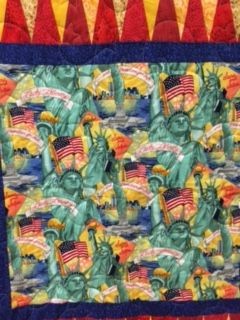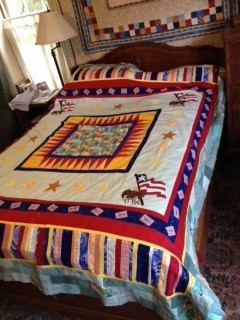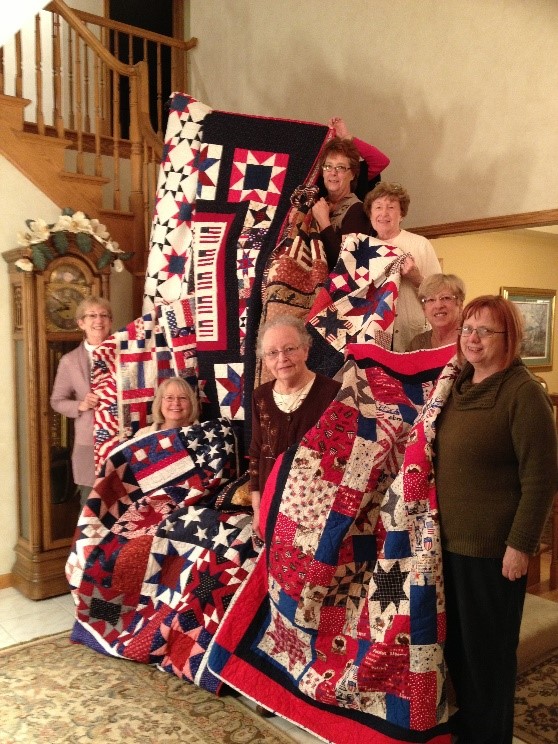Should be- Could be- in The Quilters Hall of Fame
I’ve been writing every week about Honorees of The Quilters Hall of Fame, but this time I’m going to switch up and write about people who haven’t been inducted—yet.
My inspiration, if you can call it that, was my sewing experience earlier today. Did your mother ever say, “Don’t sew on Sunday or the Devil will make you pick out your stitches with your nose”? Well, that’s what happened to me; seventeen seams in, all but four taken out. But thank goodness for my seam ripper! Or as I like to call it, the Mulligan Stick. (If you or your husband golf, you’ll recognize a Mulligan as an opportunity for a do-over. My husband turns on a wood lathe, and he can’t correct his mistakes like I can, so I try to keep a cheerful attitude about un-sewing.)
We all joke about seam rippers and the stitch removal process. We use terms like frog stitching/ ribbit; reverse sewing, etc. I recently ordered some tools online that were called stitch fixers: same thing, but with a more positive spin. So, who invented the seam ripper, and why isn’t he in The Hall of Fame?
Here’s the answer to the first question, from Tenrandomfacts.com:
Seam rippers where probably invented sometime in the late 1800s, and one of the earliest patents for a similar tool was a thimble that had the addition of a small knife that was patented in the United States by W Miller in 1883, that was used to rip threads in a similar way; while a later patent exists for a tool designed for the sole purpose of ripping seams, in 1898 by John Fisher from Canada.
Fisher’s device was a piece of twisted metal with a small blade held between two pincer-like ends. The drawing with the patent doesn’t show up well here (a better view is in the link below the photo), but you can recognize this as an ancestor of what we use today. The design evolved from the single slicer between tiny jaws into a curved blade by the 1950s, with a little knobby protector appearing later. We’ve come a long way and today we even have electric ripper scissors, but that’s too modern for me.

As an aside, I learned that I have been using my ripper incorrectly—or at least not as originally designed. Fisher prescribes the method of slashing along the seam line, but I insert the blade into every third to fifth stich on one side, and then pull up the uncut thread on the other side. At the risk of starting something akin to the toilet paper role debate, I’ll ask, “Which way do you rip?”
I couldn’t sew without John Fisher’s invention, and there are many other tools that have changed quilting in a dramatic way. How about the rotary cutter and mat? Or all those specialty rulers we know and love? And, of course, the invention with the biggest impact on our craft/art—the sewing machine. I’m sure you’ve got some favorites too. Why aren’t these inventors in the Quilters Hall of Fame?
And for that matter, why isn’t Jenny Doan of Missouri Star in? Or someone from the Modern Quilt Guild? Or that fabric designer who always comes up with a new line for you to fall in love with?
Well, the number one reason someone doesn’t get in to the Hall of Fame is that they haven’t been nominated. Yes, everyone agrees that Elias Howe and Isaac Singer made invaluable contributions to the world of quilting, but unless someone puts those names forward, they won’t be honored. There is no group at the Hall of Fame whose job it is to cast their collective mind around the quilting world and see who is worthy. Instead, the Selection Committee relies on you—actual quilters, quilt enthusiasts, scholars and historians — to present a name for consideration. It’s a way to ensure that the Committee doesn’t play favorites or skew the decision to their own ideas, but it doesn’t work unless you give them something to work with.
The process is quite simple; you can find the nomination form and instructions on the Hall of Fame website (link below). But essentially, all you have to do is “Tell how he/she has made outstanding contributions to the world of quilting.”, and provide some back up info. The website doesn’t tell you, but there are two categories of inductees, one for contemporary nominees, and the other for persons who lived/quilted 50 years ago or are deceased (Heritage Honorees).
One caution: nominations close on August 30th for selection/ announcement at following Celebration. So, you either need to get organized quickly for a 2020 submission/ 2021 decision/ 2022 induction, or take your time knowing, that the earliest your nominee would be honored would be 2023. Either way, it’s worth doing.
I submitted a nomination last year, proposing a woman from my hometown, Chicago, who had begun her quilting career around the time of the 1933 World’s Fair. The process was enjoyable and gave me the opportunity to get acquainted with my quilter’s descendants, learn more about quilting and the Century of Progress, and practice using the Quilt Index. If you go this route, you’ll soon become an expert in your area. If you propose a current quilter, you can rely on your own experiences (maybe your nominee gave a lecture or workshop at your guild), you’ll find it easy to gather data from the internet, and you may even make a connection with your nominee. Please consider making a nomination.
Next week, I’ll be back to writing about actual Honorees. Don’t ask yourself why that person was chosen. Ask why you haven’t made your choice known. (Channeling JFK here—sorry, I couldn’t resist.)
You’ve been very attentive to all this narrative, and I know that Fourth of July is coming up, so here are some photos of my Patient Piecers Bee group and our patriotic projects. The first two are a round robin started with some unusual (read: ugly; Americana prints don’t often have that coppery green) fabric, and the second is Quilts of Valor. Have a good Fourth!
Your quilting friend,
Anna
Suggested Links:


